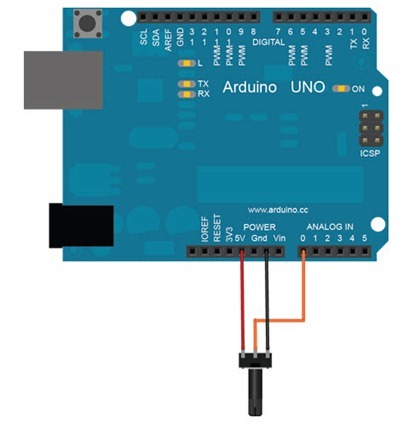Por Rui Pina para o Pplware Tutorial realizado no âmbito do Mestrado em Computação Móvel do Instituto Politécnico da Guarda na Unidade Curricular de Seminário
Amarino toolkit possibilita a comunicação via Bluetooth entre um smartphone com o Sistema Operativo Android e um microcontrolador Arduino, permitindo controlar dispositivos ligados a este. O Amarino software toolkit assenta basicamente em dois componentes: Numa aplicação Android que é executada no smartphone e em um “sketch” (programa no Arduino), escrito com as bibliotecas Amarino
No post anterior a comunicação era feita Android –> Arduino, neste post vamos mostar o contrário Arduino –> Android.
Os procedimentos de configuração são iguais aos apresentados no post anterior (ver aqui), a única diferença reside nas funções que utilizamos para enviar do Arduino e receber a informação no smartphone da Android.
Vamos colocar no Android os valores de um potenciómetro ligado ao Arduino. O Shield XBee é colocado por cima, junto com o módulo Bluetooth.
Material necessário:
- Smartphone Android
- Microcontrolador Arduino
- Modulo Bluetooth para o Arduino
- Amarino Software Toolkit
- LED
- Cabo USB
- Potenciómetro
No Android
package rp.sensordata.com;
import rp.ruipina.com.R;
import android.app.Activity;
import android.content.BroadcastReceiver;
import android.content.Context;
import android.content.Intent;
import android.content.IntentFilter;
import android.os.Bundle;
import android.widget.TextView;
import at.abraxas.amarino.Amarino;
import at.abraxas.amarino.AmarinoIntent;
public class SensorDataActivity extends Activity {
// change this to your Bluetooth device address
private static final String DEVICE_ADDRESS = "00:03:19:0D:1D:B5";
TextView tvTextoArduino;
private ArduinoReceiver arduinoReceiver = new ArduinoReceiver();
/** Called when the activity is first created. */
@Override
public void onCreate(Bundle savedInstanceState) {
super.onCreate(savedInstanceState);
setContentView(R.layout.main);
tvTextoArduino = (TextView) findViewById(R.id.tvTextoArduino);
}
@Override
protected void onStart() {
super.onStart();
// in order to receive broadcasted intents we need to register our
// receiver
registerReceiver(arduinoReceiver, new IntentFilter(AmarinoIntent.ACTION_RECEIVED));
// this is how you tell Amarino to connect to a specific BT device from
// within your own code
Amarino.connect(this, DEVICE_ADDRESS);
}
@Override
protected void onStop() {
super.onStop();
// if you connect in onStart() you must not forget to disconnect when
// your app is closed
Amarino.disconnect(this, DEVICE_ADDRESS);
// do never forget to unregister a registered receiver
unregisterReceiver(arduinoReceiver);
}
/**
* ArduinoReceiver is responsible for catching broadcasted Amarino events.
*
* It extracts data from the intent and updates the graph accordingly.
*/
public class ArduinoReceiver extends BroadcastReceiver {
@Override
public void onReceive(Context context, Intent intent) {
String data = null;
// the device address from which the data was sent, we don't need it here but to demonstrate how you retrieve it
final String address = intent.getStringExtra(AmarinoIntent.EXTRA_DEVICE_ADDRESS);
// the type of data which is added to the intent
final int dataType = intent.getIntExtra(AmarinoIntent.EXTRA_DATA_TYPE, -1);
// we only expect String data though, but it is better to check if really string was sent
// later Amarino will support differnt data types, so far data comes always as string and
// you have to parse the data to the type you have sent from Arduino, like it is shown below
if (dataType == AmarinoIntent.STRING_EXTRA){
data = intent.getStringExtra(AmarinoIntent.EXTRA_DATA);
if (data != null){
try {
tvTextoArduino.setText(data);
}
catch (NumberFormatException e) { /* oh data was not an integer */ }
}
}
}
}
}
No Arduino
/*
Sends sensor data to Arduino
(needs SensorGraph and Amarino app installed and running on Android)
*/
#include
MeetAndroid meetAndroid;
int led = 13;
int sensorValue = A0;
void setup()
{
// use the baud rate your bluetooth module is configured to
initProgram();
}
void loop()
{
meetAndroid.receive(); // you need to keep this in your loop() to receive events
// read input pin and send result to Android
meetAndroid.send(analogRead(sensorValue));
// add a little delay otherwise the phone is pretty busy
delay(100);
}
void initProgram()
{
Serial.begin(115200);
delay(2000);
Serial.print("AT+JRES\n\r"); // Reset command
delay(2000);
Serial.print("AT+JSEC=1,1,1,04,1111\n\r"); // Enable security command
delay(2000);
Serial.print("AT+JDIS=3\n\r"); // Discorable command
delay(2000);
Serial.print("AT+JRLS=1101,11,Serial Port,01,000000\n\r"); // Register local sevice command
delay(2000);
Serial.print("AT+JAAC=1\n\r"); // Auto accept connection requests command
delay(2000);
Serial.print("AT+JPCR=04,0000\r\n"); // PIN code reply
delay(2000);
//connect the phone
pinMode(led, OUTPUT);
for (int i = 0; i < 100; i++) {
// turn the pin on:
digitalWrite(led, HIGH);
delay(1000);
// turn the pin off:
digitalWrite(led, LOW);
delay(1000);
}
//wait for connection
Serial.print("AT+JSCR\r\n");
pinMode(led, OUTPUT);
digitalWrite(led,LOW);
}
Se tudo correu bem…no Android vamos ver os valores do potenciómetro.
Esperamos que tenham gostado deste tema e estamos abertos a sugestões para próximos artigos.
